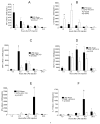An A2A adenosine receptor agonist, ATL313, reduces inflammation and improves survival in murine sepsis models
- PMID: 18937852
- PMCID: PMC2588444
- DOI: 10.1186/1471-2334-8-141
An A2A adenosine receptor agonist, ATL313, reduces inflammation and improves survival in murine sepsis models
Abstract
Background: The pathophysiology of sepsis is due in part to early systemic inflammation. Here we describe molecular and cellular responses, as well as survival, in A 2A adenosine receptor (AR) agonist treated and untreated animals during experimental sepsis.
Methods: Sepsis was induced in mice by intraperitoneal inoculation of live bacteria (Escherichia coli or Staphylococcus aureus) or lipopolysaccharide (LPS). Mice inoculated with live bacteria were treated with an A 2A AR agonist (ATL313) or phosphate buffered saline (PBS), with or without the addition of a dose of ceftriaxone. LPS inoculated mice were treated with ATL313 or PBS. Serum cytokines and chemokines were measured sequentially at 1, 2, 4, 8, and 24 hours after LPS was administered. In survival studies, mice were followed until death or for 7 days.
Results: There was a significant survival benefit in mice infected with live E. coli (100% vs. 20%, p = 0.013) or S. aureus (60% vs. 20%, p = 0.02) when treated with ATL313 in conjunction with an antibiotic versus antibiotic alone. ATL313 also improved survival from endotoxic shock when compared to PBS treatment (90% vs. 40%, p = 0.005). The serum concentrations of TNF-alpha, MIP-1 alpha, MCP-1, IFN-gamma, and IL-17 were decreased by ATL313 after LPS injection (p < 0.05). Additionally, ATL313 increased the concentration of IL-10 under the same conditions (p < 0.05). Circulating white blood cell concentrations were higher in ATL313 treated animals (p < 0.01).
Conclusion: Further studies are warranted to determine the clinical utility of ATL313 as a novel treatment for sepsis.
Figures




References
-
- DJ Burnstock G, Liang BT, Liden J. Cardiovascular Biology of Purines. 1. London: Kluwer Academic Publishers; 1998.
Publication types
MeSH terms
Substances
Grants and funding
LinkOut - more resources
Full Text Sources
Medical
Research Materials
Miscellaneous

